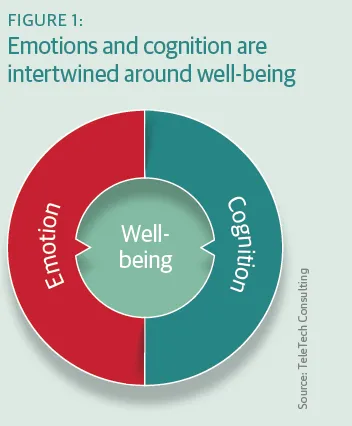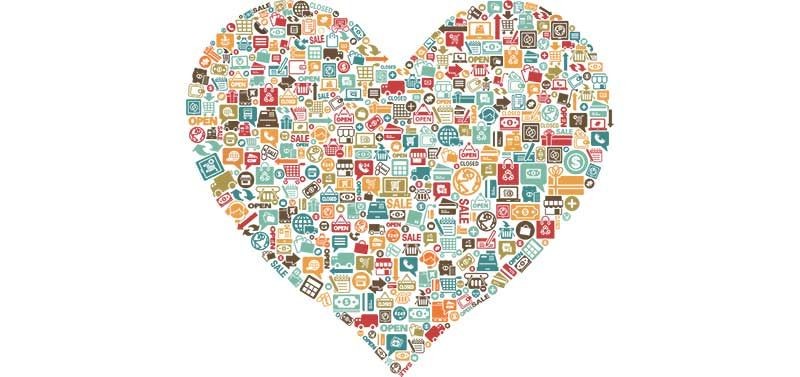No customer walks out of a store saying “that was a great 8.5 out of 10 experience.” And no customer obsessively measures each physical touchpoint of an experience to come up with an objective algorithm for personal well-being.
Instead, customers pay attention to and remember what is salient to them and ignore the rest. They use emotion to guide their decision-making.
And this is entirely understandable. Often it is impossible to calculate objectively what to do next. For instance, decisions such as, “which restaurant to go to,” “should I trust that rep,” or even “which pen should I use?’’ require an understanding of subjective preferences. Hence, while cognition identifies what we pay attention to, it’s our emotional response that tips the balance of options one way or another.
To quote neuroscientist Antonio Damasio, emotions are “not a luxury, but essential to rational thinking and normal social behavior.”

Figure 1 shows that, when considering emotion, we must consider how consumers appraise a situation with respect to their well-being, from which emotions are derived. This also shows how any emotional reaction acts as feedback to cognition; it lets us know what we should remember for next time. Professor Daniel Kahneman describes well-being in terms of the content of feelings and their intensity. For consumers this is substantially driven by goal attainment, standards of behavior, and evaluation of objects (Ortony, Clore and Collins) as they relate to what is meaningful “to me.”
In essence it’s not the emotion that matters, but what it means.
Emotion reframes CX strategy
Emotion challenges our perspective of how to deliver customer experience. Seen through its lens, customer experience becomes less about physical touchpoints and more about how they are weighted and defined by emotion. For example, rather than care about the fact that your company has a website, you should care about the website’s look, feel, and user experience. Linear journey mapping becomes less important as well, since emotions can come from anywhere, including outside the journey under consideration. Which means that companies need to enable and understand emotional encounters2 rather than deliver CX against fixed touchpoints.

Emotion expands on common customer experience concepts like customer delight and ease of doing business to include achieving personal well-being. It expands on traditional quantitative measures of customer satisfaction and sentiment to uncover hidden bias1 and “how customers” talk about their experiences; asking the question, “what does a score mean emotionally?” After all, a 9 or 10 can be just a tick in the box without emotional resilience or commitment.3
Finally, understanding customer emotions should not just be confined to preventing loss aversion. Making things work may not impact our well-being if it is a given. To create emotional engagement companies may be better off looking at designing more meaningful encounters.
An emotional framework for CX
So if emotions are important, how do we map them? Well firstly, don’t throw away any process mapping frameworks. But hold back on them until you have engaged an open process of listening and learning what the emotional customer experience is or could be.
Step 1: Become culturally attuned to emotional awareness
Engage mindset change so employees and leadership become more aware of the emotional elements of the customer experience. Ensure governance and cross-silo processes are in place that support a culture of emotional empathy.
EXAMPLE: A Swiss insurer used mobile apps to deliver weekly CX tasks to its champion network and social communities to distribute social listing into the C-suite and across departments.
Step 2: Identify emotional situations through measurement
Unfortunately, traditional voice of the customer (VOC) and voice of the employee (VOE) solutions are not set up for emotional measurement. For instance, scaled surveys are blunt instruments that assume customers are cost-benefit calculators and text analytics may over- or under-interpret emotion.
To get closer to customers, use multi-method approaches: behavioral analytics (what people do), social listening (what people say), behavioral psychology (what people don’t say), and the emerging science of story metrics. Stories are the fundamental currency of emotional response; we tell people when things go wrong, we remember anecdotes that are emotionally impactful. One vendor uses the interesting metric “more stories like this, fewer stories like that.”3
EXAMPLE: Starbucks understands that customers don’t just buy coffee, they buy the emotional demands coffee satisfies—a place to sit down and talk to friends. Functional questions such as ‘did you like that coffee’ would never get to that hidden motivation.
Step 3: Identify potential emotional opportunities
Use data from the business (through analytics and collecting ideas from staff and customers) and from benchmark experiences (such as Amazon or Mandarin Oriental) to identify opportunities to change the emotional feel of the journey. Mapping out customer ‘goal’ hierarchies may also help.
EXAMPLE: Delta Airlines used social media to collect stories. In so doing it found peaks of negative emotion about flight turnaround times among New York executives. This had a direct impact on operating expense investment and customer loyalty. Furthermore, by identifying the ‘well-being’ event, it could scan the environment for similar flashpoints.
Step 4: Collaborate across silos to prioritize innovation designs
There will be many times when a change activity requires cross-silo stakeholder support. It’s critical to get all stakeholders to agree on the program cadence and KPIs.
EXAMPLE: Financial institution RBS and telecom Du both run virtual teams with the purpose of redesigning journeys and resolving key moments of pain with input from multiple perspectives in different locations. Since issues can arise from anywhere, it’s necessary to engage all stakeholders from technology, marketing, services, and operations when developing a solution.
Step 5: Design the journey using trial and test
Enable the innovation space to design and test the emotional encounter by using fast prototyping and design thinking.
EXAMPLE: One loyalty points company set up a ‘trial and test’ environment to see the impact of creative changes. This used non-traditional KPIs attached to the activity, such as Facebook likes rather than NPS.
Step 6: Communicate emotionally with everyone
Ensure that any changes are communicated emotionally not just to customers, but also to the employees who deliver them.
EXAMPLE: American Express spread the message of success through shared employee stories. Likewise, expressions of support from top leadership built believability and commitment to customer programs.
How we feel is how we remember. In order to create personal and memorable experiences that customers are willing to pay for, it’s worth the effort to put customer emotion back into customer experience.
References:
Thanks to contributions from the following experts:
1 Dr. Simon Moore (Behavioral Psychologist, Innovation Bubble)
2 Dr. Olaf Hermans (NHTV Breda University of Applied Sciences (NL)
3 Dave Snowden (Cognitive Edge)















